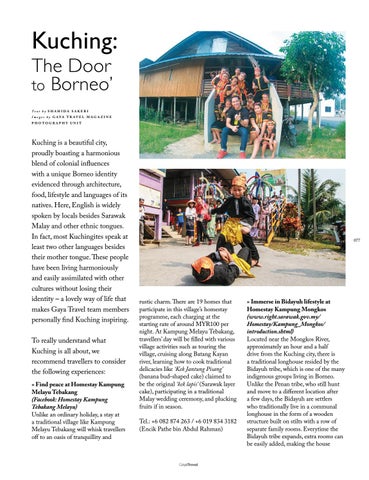Kuching: The Door to Borneo’ Te x t b y S H A H I DA S A K E R I Imeges by G AYA T RAV EL M AG A Z I N E PHOTOGRAPHY UNIT
Kuching is a beautiful city, proudly boasting a harmonious blend of colonial influences with a unique Borneo identity evidenced through architecture, food, lifestyle and languages of its natives. Here, English is widely spoken by locals besides Sarawak Malay and other ethnic tongues. In fact, most Kuchingites speak at least two other languages besides their mother tongue. These people have been living harmoniously and easily assimilated with other cultures without losing their identity – a lovely way of life that makes Gaya Travel team members personally find Kuching inspiring. To really understand what Kuching is all about, we recommend travellers to consider the following experiences: » Find peace at Homestay Kampung Melayu Tebakang (Facebook: Homestay Kampung Tebakang Melayu) Unlike an ordinary holiday, a stay at a traditional village like Kampung Melayu Tebakang will whisk travellers off to an oasis of tranquillity and
077
rustic charm. There are 19 homes that participate in this village’s homestay programme, each charging at the starting rate of around MYR100 per night. At Kampung Melayu Tebakang, travellers’ day will be filled with various village activities such as touring the village, cruising along Batang Kayan river, learning how to cook traditional delicacies like ‘Kek Jantung Pisang’ (banana bud-shaped cake) claimed to be the original ‘kek lapis’ (Sarawak layer cake), participating in a traditional Malay wedding ceremony, and plucking fruits if in season. Tel.: +6 082 874 263 / +6 019 834 3182 (Encik Pathe bin Abdul Rahman)
» Immerse in Bidayuh lifestyle at Homestay Kampung Mongkos (www.right.sarawak.gov.my/ Homestay/Kampung_Mongkos/ introduction.shtml) Located near the Mongkos River, approximately an hour and a half drive from the Kuching city, there is a traditional longhouse resided by the Bidayuh tribe, which is one of the many indigenous groups living in Borneo. Unlike the Penan tribe, who still hunt and move to a different location after a few days, the Bidayuh are settlers who traditionally live in a communal longhouse in the form of a wooden structure built on stilts with a row of separate family rooms. Everytime the Bidayuh tribe expands, extra rooms can be easily added, making the house






















